The Effectiveness of Phonics in Reading Instruction
VerifiedAdded on 2020/05/16
|14
|3111
|170
AI Summary
This assignment delves into the efficacy of synthetic phonics as a method for teaching reading. It analyzes various research papers that investigate the relationship between phonics instruction and reading attainment in both first and second languages. The assignment explores the theoretical underpinnings of phonics, examines the impact of different phonics interventions, and considers the role of phonics in addressing reading difficulties.
Contribute Materials
Your contribution can guide someone’s learning journey. Share your
documents today.

Running Head: CLASSROOM PLANNING AND PROGRAMMING FOR A CHILD
Classroom planning and programming for a child
Name of the Student
Name of the University
Author Note
Classroom planning and programming for a child
Name of the Student
Name of the University
Author Note
Secure Best Marks with AI Grader
Need help grading? Try our AI Grader for instant feedback on your assignments.
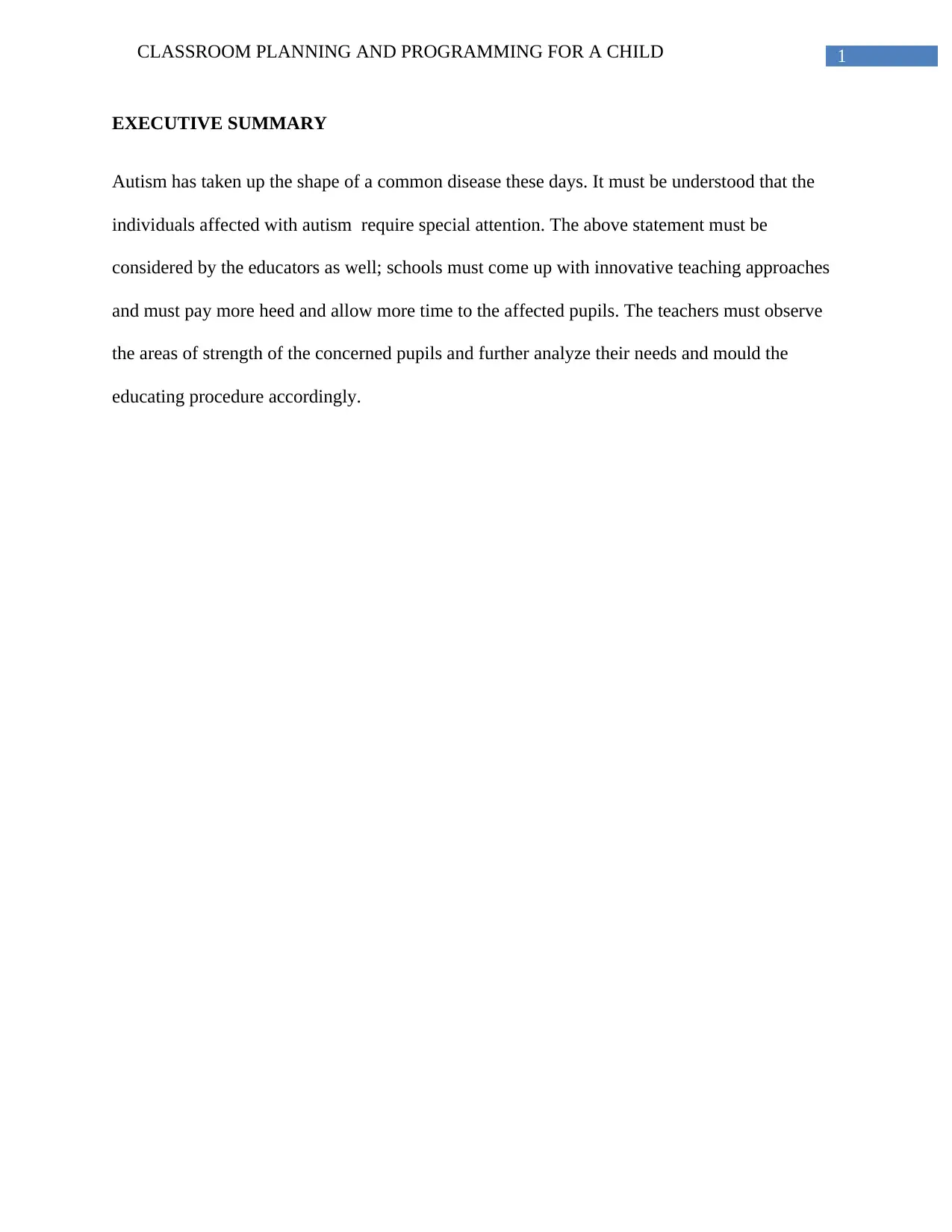
1CLASSROOM PLANNING AND PROGRAMMING FOR A CHILD
EXECUTIVE SUMMARY
Autism has taken up the shape of a common disease these days. It must be understood that the
individuals affected with autism require special attention. The above statement must be
considered by the educators as well; schools must come up with innovative teaching approaches
and must pay more heed and allow more time to the affected pupils. The teachers must observe
the areas of strength of the concerned pupils and further analyze their needs and mould the
educating procedure accordingly.
EXECUTIVE SUMMARY
Autism has taken up the shape of a common disease these days. It must be understood that the
individuals affected with autism require special attention. The above statement must be
considered by the educators as well; schools must come up with innovative teaching approaches
and must pay more heed and allow more time to the affected pupils. The teachers must observe
the areas of strength of the concerned pupils and further analyze their needs and mould the
educating procedure accordingly.
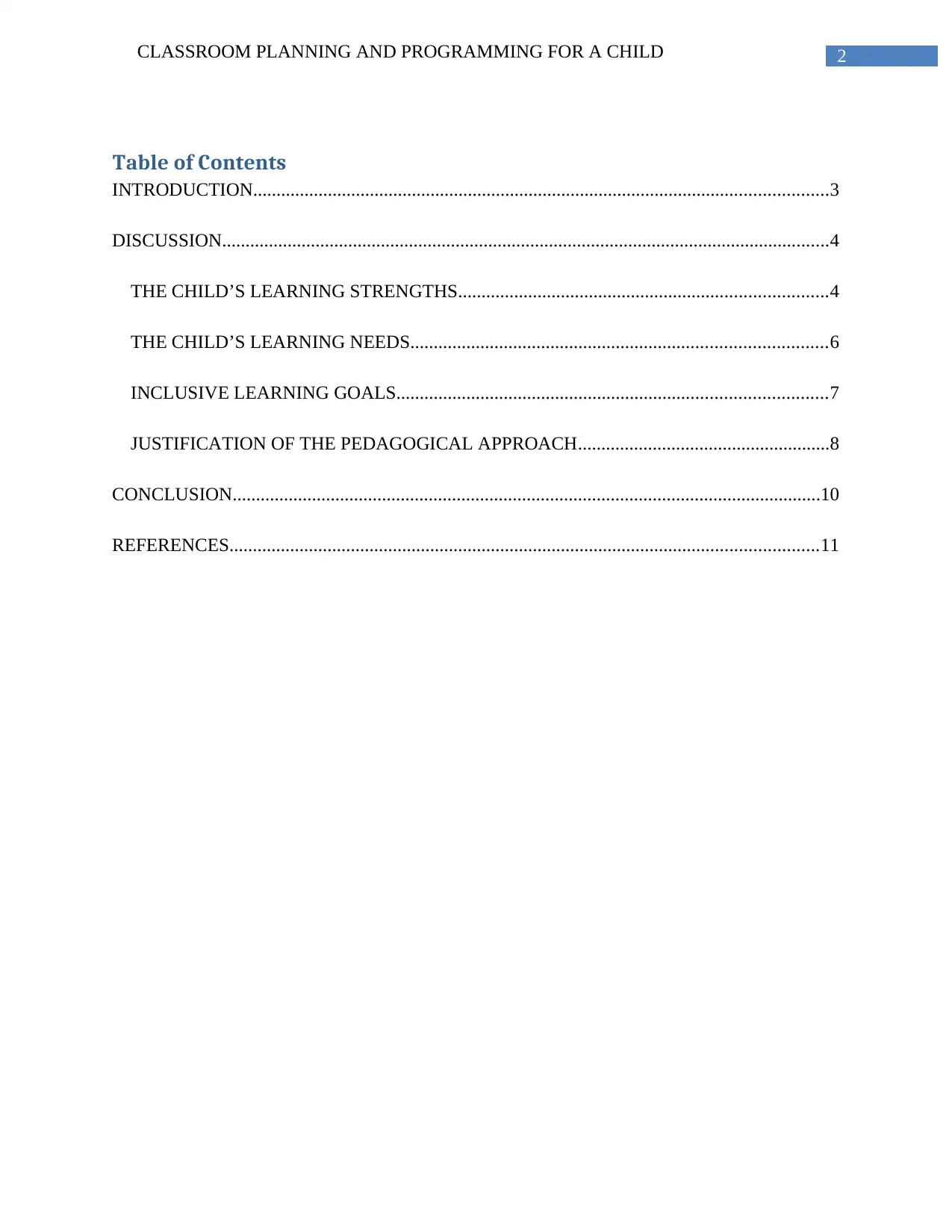
2CLASSROOM PLANNING AND PROGRAMMING FOR A CHILD
Table of Contents
INTRODUCTION...........................................................................................................................3
DISCUSSION..................................................................................................................................4
THE CHILD’S LEARNING STRENGTHS...............................................................................4
THE CHILD’S LEARNING NEEDS.........................................................................................6
INCLUSIVE LEARNING GOALS............................................................................................7
JUSTIFICATION OF THE PEDAGOGICAL APPROACH......................................................8
CONCLUSION..............................................................................................................................10
REFERENCES..............................................................................................................................11
Table of Contents
INTRODUCTION...........................................................................................................................3
DISCUSSION..................................................................................................................................4
THE CHILD’S LEARNING STRENGTHS...............................................................................4
THE CHILD’S LEARNING NEEDS.........................................................................................6
INCLUSIVE LEARNING GOALS............................................................................................7
JUSTIFICATION OF THE PEDAGOGICAL APPROACH......................................................8
CONCLUSION..............................................................................................................................10
REFERENCES..............................................................................................................................11
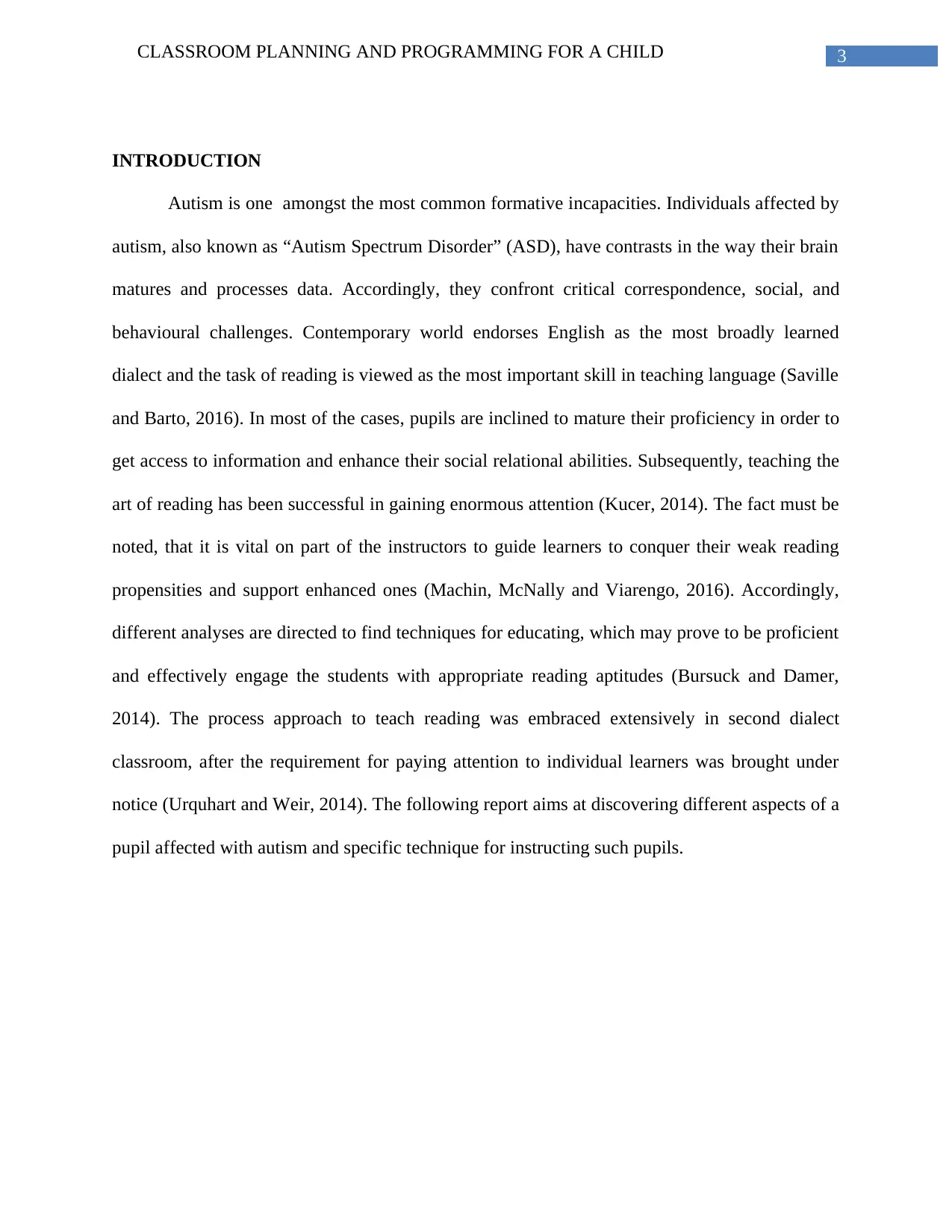
3CLASSROOM PLANNING AND PROGRAMMING FOR A CHILD
INTRODUCTION
Autism is one amongst the most common formative incapacities. Individuals affected by
autism, also known as “Autism Spectrum Disorder” (ASD), have contrasts in the way their brain
matures and processes data. Accordingly, they confront critical correspondence, social, and
behavioural challenges. Contemporary world endorses English as the most broadly learned
dialect and the task of reading is viewed as the most important skill in teaching language (Saville
and Barto, 2016). In most of the cases, pupils are inclined to mature their proficiency in order to
get access to information and enhance their social relational abilities. Subsequently, teaching the
art of reading has been successful in gaining enormous attention (Kucer, 2014). The fact must be
noted, that it is vital on part of the instructors to guide learners to conquer their weak reading
propensities and support enhanced ones (Machin, McNally and Viarengo, 2016). Accordingly,
different analyses are directed to find techniques for educating, which may prove to be proficient
and effectively engage the students with appropriate reading aptitudes (Bursuck and Damer,
2014). The process approach to teach reading was embraced extensively in second dialect
classroom, after the requirement for paying attention to individual learners was brought under
notice (Urquhart and Weir, 2014). The following report aims at discovering different aspects of a
pupil affected with autism and specific technique for instructing such pupils.
INTRODUCTION
Autism is one amongst the most common formative incapacities. Individuals affected by
autism, also known as “Autism Spectrum Disorder” (ASD), have contrasts in the way their brain
matures and processes data. Accordingly, they confront critical correspondence, social, and
behavioural challenges. Contemporary world endorses English as the most broadly learned
dialect and the task of reading is viewed as the most important skill in teaching language (Saville
and Barto, 2016). In most of the cases, pupils are inclined to mature their proficiency in order to
get access to information and enhance their social relational abilities. Subsequently, teaching the
art of reading has been successful in gaining enormous attention (Kucer, 2014). The fact must be
noted, that it is vital on part of the instructors to guide learners to conquer their weak reading
propensities and support enhanced ones (Machin, McNally and Viarengo, 2016). Accordingly,
different analyses are directed to find techniques for educating, which may prove to be proficient
and effectively engage the students with appropriate reading aptitudes (Bursuck and Damer,
2014). The process approach to teach reading was embraced extensively in second dialect
classroom, after the requirement for paying attention to individual learners was brought under
notice (Urquhart and Weir, 2014). The following report aims at discovering different aspects of a
pupil affected with autism and specific technique for instructing such pupils.
Secure Best Marks with AI Grader
Need help grading? Try our AI Grader for instant feedback on your assignments.
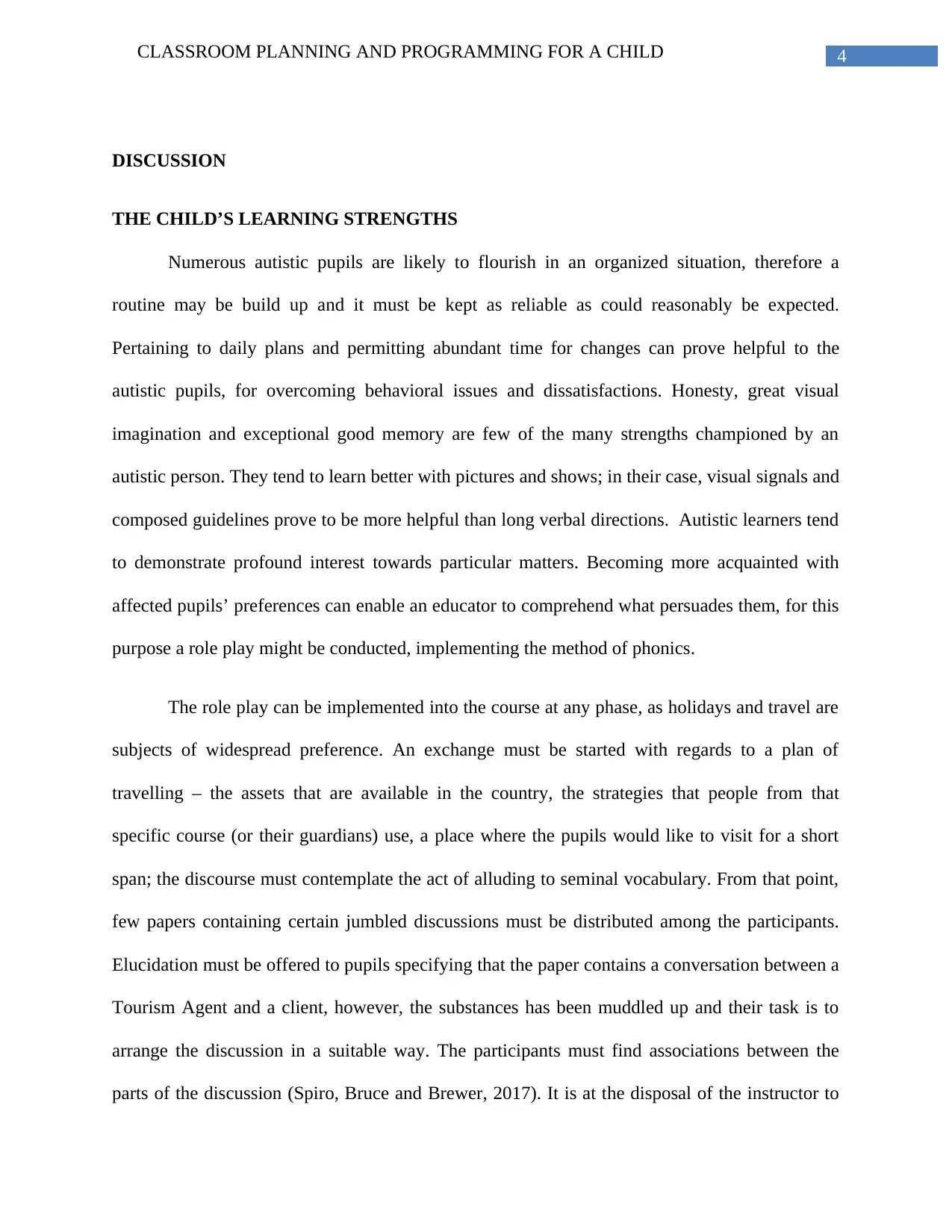
4CLASSROOM PLANNING AND PROGRAMMING FOR A CHILD
DISCUSSION
THE CHILD’S LEARNING STRENGTHS
Numerous autistic pupils are likely to flourish in an organized situation, therefore a
routine may be build up and it must be kept as reliable as could reasonably be expected.
Pertaining to daily plans and permitting abundant time for changes can prove helpful to the
autistic pupils, for overcoming behavioral issues and dissatisfactions. Honesty, great visual
imagination and exceptional good memory are few of the many strengths championed by an
autistic person. They tend to learn better with pictures and shows; in their case, visual signals and
composed guidelines prove to be more helpful than long verbal directions. Autistic learners tend
to demonstrate profound interest towards particular matters. Becoming more acquainted with
affected pupils’ preferences can enable an educator to comprehend what persuades them, for this
purpose a role play might be conducted, implementing the method of phonics.
The role play can be implemented into the course at any phase, as holidays and travel are
subjects of widespread preference. An exchange must be started with regards to a plan of
travelling – the assets that are available in the country, the strategies that people from that
specific course (or their guardians) use, a place where the pupils would like to visit for a short
span; the discourse must contemplate the act of alluding to seminal vocabulary. From that point,
few papers containing certain jumbled discussions must be distributed among the participants.
Elucidation must be offered to pupils specifying that the paper contains a conversation between a
Tourism Agent and a client, however, the substances has been muddled up and their task is to
arrange the discussion in a suitable way. The participants must find associations between the
parts of the discussion (Spiro, Bruce and Brewer, 2017). It is at the disposal of the instructor to
DISCUSSION
THE CHILD’S LEARNING STRENGTHS
Numerous autistic pupils are likely to flourish in an organized situation, therefore a
routine may be build up and it must be kept as reliable as could reasonably be expected.
Pertaining to daily plans and permitting abundant time for changes can prove helpful to the
autistic pupils, for overcoming behavioral issues and dissatisfactions. Honesty, great visual
imagination and exceptional good memory are few of the many strengths championed by an
autistic person. They tend to learn better with pictures and shows; in their case, visual signals and
composed guidelines prove to be more helpful than long verbal directions. Autistic learners tend
to demonstrate profound interest towards particular matters. Becoming more acquainted with
affected pupils’ preferences can enable an educator to comprehend what persuades them, for this
purpose a role play might be conducted, implementing the method of phonics.
The role play can be implemented into the course at any phase, as holidays and travel are
subjects of widespread preference. An exchange must be started with regards to a plan of
travelling – the assets that are available in the country, the strategies that people from that
specific course (or their guardians) use, a place where the pupils would like to visit for a short
span; the discourse must contemplate the act of alluding to seminal vocabulary. From that point,
few papers containing certain jumbled discussions must be distributed among the participants.
Elucidation must be offered to pupils specifying that the paper contains a conversation between a
Tourism Agent and a client, however, the substances has been muddled up and their task is to
arrange the discussion in a suitable way. The participants must find associations between the
parts of the discussion (Spiro, Bruce and Brewer, 2017). It is at the disposal of the instructor to
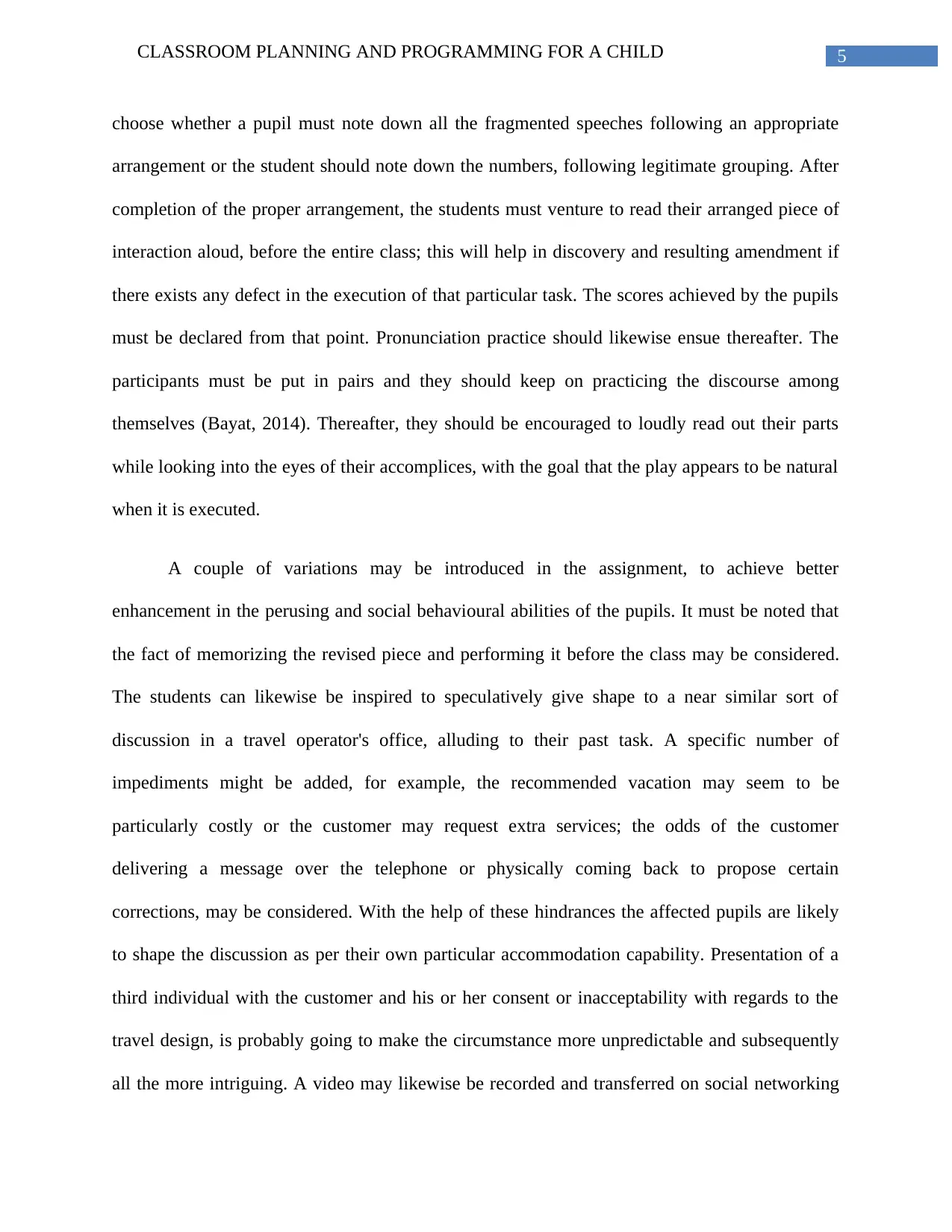
5CLASSROOM PLANNING AND PROGRAMMING FOR A CHILD
choose whether a pupil must note down all the fragmented speeches following an appropriate
arrangement or the student should note down the numbers, following legitimate grouping. After
completion of the proper arrangement, the students must venture to read their arranged piece of
interaction aloud, before the entire class; this will help in discovery and resulting amendment if
there exists any defect in the execution of that particular task. The scores achieved by the pupils
must be declared from that point. Pronunciation practice should likewise ensue thereafter. The
participants must be put in pairs and they should keep on practicing the discourse among
themselves (Bayat, 2014). Thereafter, they should be encouraged to loudly read out their parts
while looking into the eyes of their accomplices, with the goal that the play appears to be natural
when it is executed.
A couple of variations may be introduced in the assignment, to achieve better
enhancement in the perusing and social behavioural abilities of the pupils. It must be noted that
the fact of memorizing the revised piece and performing it before the class may be considered.
The students can likewise be inspired to speculatively give shape to a near similar sort of
discussion in a travel operator's office, alluding to their past task. A specific number of
impediments might be added, for example, the recommended vacation may seem to be
particularly costly or the customer may request extra services; the odds of the customer
delivering a message over the telephone or physically coming back to propose certain
corrections, may be considered. With the help of these hindrances the affected pupils are likely
to shape the discussion as per their own particular accommodation capability. Presentation of a
third individual with the customer and his or her consent or inacceptability with regards to the
travel design, is probably going to make the circumstance more unpredictable and subsequently
all the more intriguing. A video may likewise be recorded and transferred on social networking
choose whether a pupil must note down all the fragmented speeches following an appropriate
arrangement or the student should note down the numbers, following legitimate grouping. After
completion of the proper arrangement, the students must venture to read their arranged piece of
interaction aloud, before the entire class; this will help in discovery and resulting amendment if
there exists any defect in the execution of that particular task. The scores achieved by the pupils
must be declared from that point. Pronunciation practice should likewise ensue thereafter. The
participants must be put in pairs and they should keep on practicing the discourse among
themselves (Bayat, 2014). Thereafter, they should be encouraged to loudly read out their parts
while looking into the eyes of their accomplices, with the goal that the play appears to be natural
when it is executed.
A couple of variations may be introduced in the assignment, to achieve better
enhancement in the perusing and social behavioural abilities of the pupils. It must be noted that
the fact of memorizing the revised piece and performing it before the class may be considered.
The students can likewise be inspired to speculatively give shape to a near similar sort of
discussion in a travel operator's office, alluding to their past task. A specific number of
impediments might be added, for example, the recommended vacation may seem to be
particularly costly or the customer may request extra services; the odds of the customer
delivering a message over the telephone or physically coming back to propose certain
corrections, may be considered. With the help of these hindrances the affected pupils are likely
to shape the discussion as per their own particular accommodation capability. Presentation of a
third individual with the customer and his or her consent or inacceptability with regards to the
travel design, is probably going to make the circumstance more unpredictable and subsequently
all the more intriguing. A video may likewise be recorded and transferred on social networking

6CLASSROOM PLANNING AND PROGRAMMING FOR A CHILD
sits, the responses are certain to encourage the affected learners to further develop their abilities
(Wagner, Vollmar and Wagner, 2014).
The government of Queensland encourages eminent “Education Adjustment Programs”
[http://education.qld.gov.au/students/disabilities/adjustment/pdfs/eap-handbook.pdf], which
includes programs to aid education, for instance ADOS, which stands for Autism Diagnostic
Observation Schedule. It's a standard assessment used to survey social and correspondence
conduct in a mental imbalance. Results are likely to help direct an affected child’s individualized
training design .
THE CHILD’S LEARNING NEEDS
Symptoms of autism might be serious and meddle with regular undertakings, or they can
be trivial and lead to negligible problems (Hadjikhani et al., 2015). Indications of autism are
likely to include the following:
o Inconvenience while intermingling, playing, or identifying with others
o Very brief or no eye to eye connection with fellow beings
o Peculiar or recurring movements, for example, hand fluttering, tapping or turning
o Impediment in seminal developments or loss of knowledge accomplished before
o Hindrances while being educated in school
o Getting involved with playthings in a manner which may appear to be odd or
tedious
o Scanty spatial awareness and clumsiness
Teachers must bring into consideration the following behavioural traits of pupils affected
with autism :
sits, the responses are certain to encourage the affected learners to further develop their abilities
(Wagner, Vollmar and Wagner, 2014).
The government of Queensland encourages eminent “Education Adjustment Programs”
[http://education.qld.gov.au/students/disabilities/adjustment/pdfs/eap-handbook.pdf], which
includes programs to aid education, for instance ADOS, which stands for Autism Diagnostic
Observation Schedule. It's a standard assessment used to survey social and correspondence
conduct in a mental imbalance. Results are likely to help direct an affected child’s individualized
training design .
THE CHILD’S LEARNING NEEDS
Symptoms of autism might be serious and meddle with regular undertakings, or they can
be trivial and lead to negligible problems (Hadjikhani et al., 2015). Indications of autism are
likely to include the following:
o Inconvenience while intermingling, playing, or identifying with others
o Very brief or no eye to eye connection with fellow beings
o Peculiar or recurring movements, for example, hand fluttering, tapping or turning
o Impediment in seminal developments or loss of knowledge accomplished before
o Hindrances while being educated in school
o Getting involved with playthings in a manner which may appear to be odd or
tedious
o Scanty spatial awareness and clumsiness
Teachers must bring into consideration the following behavioural traits of pupils affected
with autism :
Paraphrase This Document
Need a fresh take? Get an instant paraphrase of this document with our AI Paraphraser

7CLASSROOM PLANNING AND PROGRAMMING FOR A CHILD
Acquire disappointment with ease
Need to visit school’s quarantine for medical assistance
Miss class time for checkups and treatments
Experience difficulty talking or not talk by any means
Appear to be heartless or apathetic
Require additional time for class assignments and homework
Need to appear for exams in an isolated area, away from diversions .
A wide structure must be established and the understanding that each learner affected by
autism is exceptional, which implies every affected pupil possess distinctive symptoms and
exclusive procedures of learning, must be acquired by teachers. Every pupil with an ASD needs
individual consideration; phonics method of acquiring reading skills has proved to be very
effective in this domain. Autistic children need to learn from the conduct of their cohorts. They
also require early and consistent intercession, which plays a vital role in helping them to develop
social abilities. Similarly, behavioral issues also need to be addressed before they turn to be real
obstacles.
INCLUSIVE LEARNING GOALS
Reading is a capacity that students must acquire, by following directions in a sorted out
and efficient manner, to be able to internalize the crucial capacities to decipher the words and
letters that are to be read in not so distant future (Reutzel, 2014). Instructing students to peruse,
using the technique of phonics, is relatively a straightforward and convincing methodology
(Kelly, 2015). Learners affected with autism are expected to possess the capacity to use this
method of learning, and utilize it to articulate new words that they hear or see (Hidajat, Susanto
and Iskandar, 2017). This is the essential basic approach in making sense of the technique for
Acquire disappointment with ease
Need to visit school’s quarantine for medical assistance
Miss class time for checkups and treatments
Experience difficulty talking or not talk by any means
Appear to be heartless or apathetic
Require additional time for class assignments and homework
Need to appear for exams in an isolated area, away from diversions .
A wide structure must be established and the understanding that each learner affected by
autism is exceptional, which implies every affected pupil possess distinctive symptoms and
exclusive procedures of learning, must be acquired by teachers. Every pupil with an ASD needs
individual consideration; phonics method of acquiring reading skills has proved to be very
effective in this domain. Autistic children need to learn from the conduct of their cohorts. They
also require early and consistent intercession, which plays a vital role in helping them to develop
social abilities. Similarly, behavioral issues also need to be addressed before they turn to be real
obstacles.
INCLUSIVE LEARNING GOALS
Reading is a capacity that students must acquire, by following directions in a sorted out
and efficient manner, to be able to internalize the crucial capacities to decipher the words and
letters that are to be read in not so distant future (Reutzel, 2014). Instructing students to peruse,
using the technique of phonics, is relatively a straightforward and convincing methodology
(Kelly, 2015). Learners affected with autism are expected to possess the capacity to use this
method of learning, and utilize it to articulate new words that they hear or see (Hidajat, Susanto
and Iskandar, 2017). This is the essential basic approach in making sense of the technique for
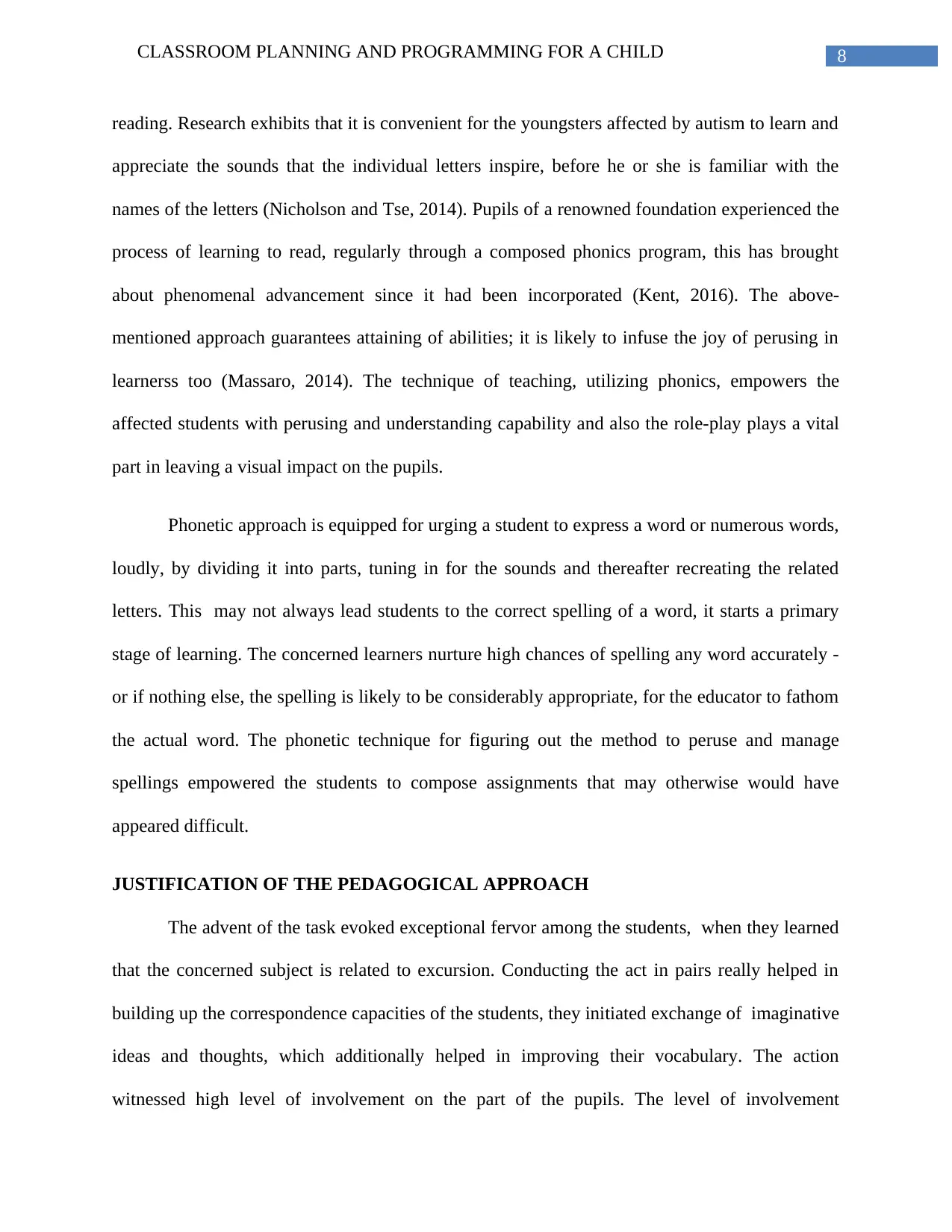
8CLASSROOM PLANNING AND PROGRAMMING FOR A CHILD
reading. Research exhibits that it is convenient for the youngsters affected by autism to learn and
appreciate the sounds that the individual letters inspire, before he or she is familiar with the
names of the letters (Nicholson and Tse, 2014). Pupils of a renowned foundation experienced the
process of learning to read, regularly through a composed phonics program, this has brought
about phenomenal advancement since it had been incorporated (Kent, 2016). The above-
mentioned approach guarantees attaining of abilities; it is likely to infuse the joy of perusing in
learnerss too (Massaro, 2014). The technique of teaching, utilizing phonics, empowers the
affected students with perusing and understanding capability and also the role-play plays a vital
part in leaving a visual impact on the pupils.
Phonetic approach is equipped for urging a student to express a word or numerous words,
loudly, by dividing it into parts, tuning in for the sounds and thereafter recreating the related
letters. This may not always lead students to the correct spelling of a word, it starts a primary
stage of learning. The concerned learners nurture high chances of spelling any word accurately -
or if nothing else, the spelling is likely to be considerably appropriate, for the educator to fathom
the actual word. The phonetic technique for figuring out the method to peruse and manage
spellings empowered the students to compose assignments that may otherwise would have
appeared difficult.
JUSTIFICATION OF THE PEDAGOGICAL APPROACH
The advent of the task evoked exceptional fervor among the students, when they learned
that the concerned subject is related to excursion. Conducting the act in pairs really helped in
building up the correspondence capacities of the students, they initiated exchange of imaginative
ideas and thoughts, which additionally helped in improving their vocabulary. The action
witnessed high level of involvement on the part of the pupils. The level of involvement
reading. Research exhibits that it is convenient for the youngsters affected by autism to learn and
appreciate the sounds that the individual letters inspire, before he or she is familiar with the
names of the letters (Nicholson and Tse, 2014). Pupils of a renowned foundation experienced the
process of learning to read, regularly through a composed phonics program, this has brought
about phenomenal advancement since it had been incorporated (Kent, 2016). The above-
mentioned approach guarantees attaining of abilities; it is likely to infuse the joy of perusing in
learnerss too (Massaro, 2014). The technique of teaching, utilizing phonics, empowers the
affected students with perusing and understanding capability and also the role-play plays a vital
part in leaving a visual impact on the pupils.
Phonetic approach is equipped for urging a student to express a word or numerous words,
loudly, by dividing it into parts, tuning in for the sounds and thereafter recreating the related
letters. This may not always lead students to the correct spelling of a word, it starts a primary
stage of learning. The concerned learners nurture high chances of spelling any word accurately -
or if nothing else, the spelling is likely to be considerably appropriate, for the educator to fathom
the actual word. The phonetic technique for figuring out the method to peruse and manage
spellings empowered the students to compose assignments that may otherwise would have
appeared difficult.
JUSTIFICATION OF THE PEDAGOGICAL APPROACH
The advent of the task evoked exceptional fervor among the students, when they learned
that the concerned subject is related to excursion. Conducting the act in pairs really helped in
building up the correspondence capacities of the students, they initiated exchange of imaginative
ideas and thoughts, which additionally helped in improving their vocabulary. The action
witnessed high level of involvement on the part of the pupils. The level of involvement

9CLASSROOM PLANNING AND PROGRAMMING FOR A CHILD
additionally expanded when the complexities of circumstance expanded. The assignment of
connecting fragmented pieces was fruitful in viably capturing the attention of the concerned
learners. Reading the task loudly was exceptionally compelling, as it had called attention to the
regions of quality and shortcoming of the reading areas of a specific pupil and thus prepared
aground for achieving improvement in the sphere of perusing practice.
Phonics encourages affected pupils to read by recognizing and articulating sounds
(Warnick and Caldarella, 2016).Through a composed approach they come to know about the
strategy to hear the sounds that each letter evokes, they are made to mix those sounds together
from left to build a word. Learners would then have the capacity to use this data to unwind new
words that they see or hear. This is the essential basic progress in gaining sense of how to read.
Pupils who have been prepared by following the strategy of phonics, tend to read more precisely
than the individuals who have been prepared using diverse strategies (Pressley and Allington,
2014).. The technique for perusing effectively starts by perceiving sounds and achieving the
normal ability to thereafter translate words (Steacy, 2016). This strategy however requests
consistent exercise with the goal that the word decoding procedure may be directed instantly.
additionally expanded when the complexities of circumstance expanded. The assignment of
connecting fragmented pieces was fruitful in viably capturing the attention of the concerned
learners. Reading the task loudly was exceptionally compelling, as it had called attention to the
regions of quality and shortcoming of the reading areas of a specific pupil and thus prepared
aground for achieving improvement in the sphere of perusing practice.
Phonics encourages affected pupils to read by recognizing and articulating sounds
(Warnick and Caldarella, 2016).Through a composed approach they come to know about the
strategy to hear the sounds that each letter evokes, they are made to mix those sounds together
from left to build a word. Learners would then have the capacity to use this data to unwind new
words that they see or hear. This is the essential basic progress in gaining sense of how to read.
Pupils who have been prepared by following the strategy of phonics, tend to read more precisely
than the individuals who have been prepared using diverse strategies (Pressley and Allington,
2014).. The technique for perusing effectively starts by perceiving sounds and achieving the
normal ability to thereafter translate words (Steacy, 2016). This strategy however requests
consistent exercise with the goal that the word decoding procedure may be directed instantly.
Secure Best Marks with AI Grader
Need help grading? Try our AI Grader for instant feedback on your assignments.
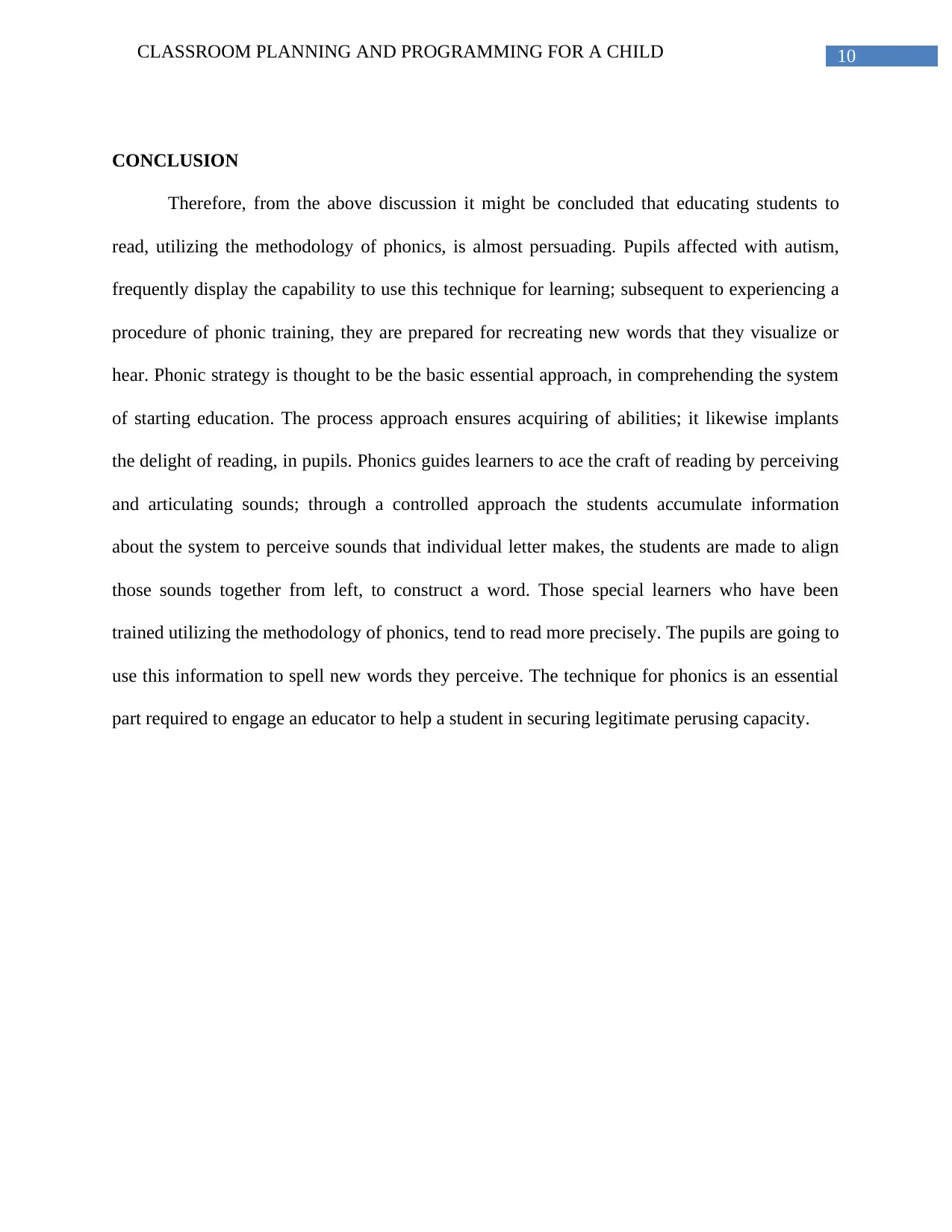
10CLASSROOM PLANNING AND PROGRAMMING FOR A CHILD
CONCLUSION
Therefore, from the above discussion it might be concluded that educating students to
read, utilizing the methodology of phonics, is almost persuading. Pupils affected with autism,
frequently display the capability to use this technique for learning; subsequent to experiencing a
procedure of phonic training, they are prepared for recreating new words that they visualize or
hear. Phonic strategy is thought to be the basic essential approach, in comprehending the system
of starting education. The process approach ensures acquiring of abilities; it likewise implants
the delight of reading, in pupils. Phonics guides learners to ace the craft of reading by perceiving
and articulating sounds; through a controlled approach the students accumulate information
about the system to perceive sounds that individual letter makes, the students are made to align
those sounds together from left, to construct a word. Those special learners who have been
trained utilizing the methodology of phonics, tend to read more precisely. The pupils are going to
use this information to spell new words they perceive. The technique for phonics is an essential
part required to engage an educator to help a student in securing legitimate perusing capacity.
CONCLUSION
Therefore, from the above discussion it might be concluded that educating students to
read, utilizing the methodology of phonics, is almost persuading. Pupils affected with autism,
frequently display the capability to use this technique for learning; subsequent to experiencing a
procedure of phonic training, they are prepared for recreating new words that they visualize or
hear. Phonic strategy is thought to be the basic essential approach, in comprehending the system
of starting education. The process approach ensures acquiring of abilities; it likewise implants
the delight of reading, in pupils. Phonics guides learners to ace the craft of reading by perceiving
and articulating sounds; through a controlled approach the students accumulate information
about the system to perceive sounds that individual letter makes, the students are made to align
those sounds together from left, to construct a word. Those special learners who have been
trained utilizing the methodology of phonics, tend to read more precisely. The pupils are going to
use this information to spell new words they perceive. The technique for phonics is an essential
part required to engage an educator to help a student in securing legitimate perusing capacity.
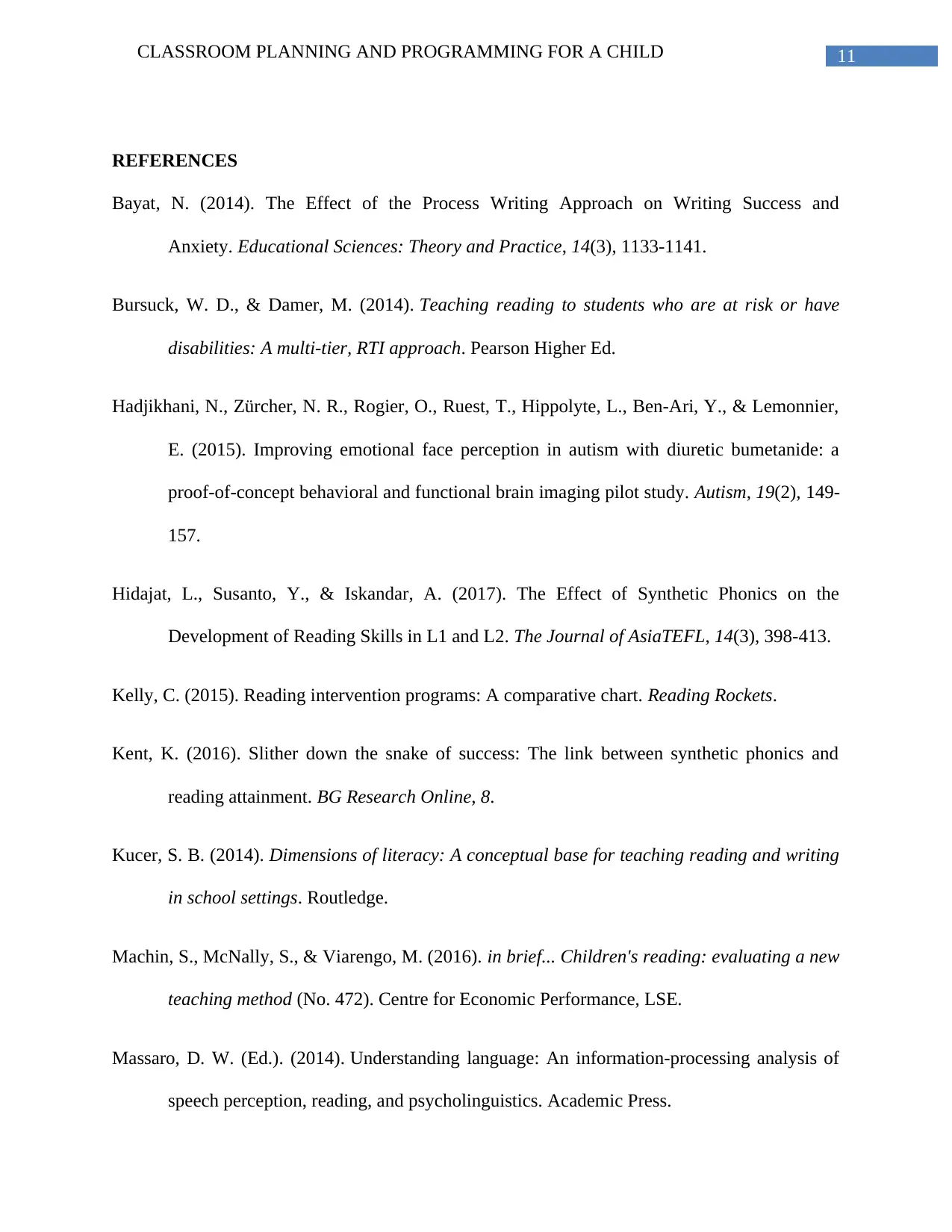
11CLASSROOM PLANNING AND PROGRAMMING FOR A CHILD
REFERENCES
Bayat, N. (2014). The Effect of the Process Writing Approach on Writing Success and
Anxiety. Educational Sciences: Theory and Practice, 14(3), 1133-1141.
Bursuck, W. D., & Damer, M. (2014). Teaching reading to students who are at risk or have
disabilities: A multi-tier, RTI approach. Pearson Higher Ed.
Hadjikhani, N., Zürcher, N. R., Rogier, O., Ruest, T., Hippolyte, L., Ben-Ari, Y., & Lemonnier,
E. (2015). Improving emotional face perception in autism with diuretic bumetanide: a
proof-of-concept behavioral and functional brain imaging pilot study. Autism, 19(2), 149-
157.
Hidajat, L., Susanto, Y., & Iskandar, A. (2017). The Effect of Synthetic Phonics on the
Development of Reading Skills in L1 and L2. The Journal of AsiaTEFL, 14(3), 398-413.
Kelly, C. (2015). Reading intervention programs: A comparative chart. Reading Rockets.
Kent, K. (2016). Slither down the snake of success: The link between synthetic phonics and
reading attainment. BG Research Online, 8.
Kucer, S. B. (2014). Dimensions of literacy: A conceptual base for teaching reading and writing
in school settings. Routledge.
Machin, S., McNally, S., & Viarengo, M. (2016). in brief... Children's reading: evaluating a new
teaching method (No. 472). Centre for Economic Performance, LSE.
Massaro, D. W. (Ed.). (2014). Understanding language: An information-processing analysis of
speech perception, reading, and psycholinguistics. Academic Press.
REFERENCES
Bayat, N. (2014). The Effect of the Process Writing Approach on Writing Success and
Anxiety. Educational Sciences: Theory and Practice, 14(3), 1133-1141.
Bursuck, W. D., & Damer, M. (2014). Teaching reading to students who are at risk or have
disabilities: A multi-tier, RTI approach. Pearson Higher Ed.
Hadjikhani, N., Zürcher, N. R., Rogier, O., Ruest, T., Hippolyte, L., Ben-Ari, Y., & Lemonnier,
E. (2015). Improving emotional face perception in autism with diuretic bumetanide: a
proof-of-concept behavioral and functional brain imaging pilot study. Autism, 19(2), 149-
157.
Hidajat, L., Susanto, Y., & Iskandar, A. (2017). The Effect of Synthetic Phonics on the
Development of Reading Skills in L1 and L2. The Journal of AsiaTEFL, 14(3), 398-413.
Kelly, C. (2015). Reading intervention programs: A comparative chart. Reading Rockets.
Kent, K. (2016). Slither down the snake of success: The link between synthetic phonics and
reading attainment. BG Research Online, 8.
Kucer, S. B. (2014). Dimensions of literacy: A conceptual base for teaching reading and writing
in school settings. Routledge.
Machin, S., McNally, S., & Viarengo, M. (2016). in brief... Children's reading: evaluating a new
teaching method (No. 472). Centre for Economic Performance, LSE.
Massaro, D. W. (Ed.). (2014). Understanding language: An information-processing analysis of
speech perception, reading, and psycholinguistics. Academic Press.

12CLASSROOM PLANNING AND PROGRAMMING FOR A CHILD
Nicholson, T. W., & Tse, L. M. (2014). The effect of phonics-enhanced Big Book reading on the
language and literacy skills of six-year-old pupils of different reading ability attending
lower SES schools.
Pressley, M., & Allington, R. L. (2014). Reading instruction that works: The case for balanced
teaching. Guilford Publications.
Reutzel, D. R., Brandt, L., Fawson, P. C., & Jones, C. D. (2014). Exploration of the Consortium
on Reading Excellence Phonics Survey: An Instrument for Assessing Primary-Grade
Students' Phonics Knowledge. The Elementary School Journal, 115(1), 49-72.
Saville-Troike, M., & Barto, K. (2016). Introducing second language acquisition. Cambridge
University Press.
Spiro, R. J., Bruce, B. C., & Brewer, W. F. (Eds.). (2017). Theoretical issues in reading
comprehension: Perspectives from cognitive psychology, linguistics, artificial
intelligence and education (Vol. 11). Routledge.
Steacy, L. M., Elleman, A. M., Lovett, M. W., & Compton, D. L. (2016). Exploring differential
effects across two decoding treatments on item-level transfer in children with significant
word reading difficulties: A new approach for testing intervention elements. Scientific
Studies of Reading, 20(4), 283-295.
Urquhart, A. H., & Weir, C. J. (2014). Reading in a second language: Process, product and
practice. Routledge.
Nicholson, T. W., & Tse, L. M. (2014). The effect of phonics-enhanced Big Book reading on the
language and literacy skills of six-year-old pupils of different reading ability attending
lower SES schools.
Pressley, M., & Allington, R. L. (2014). Reading instruction that works: The case for balanced
teaching. Guilford Publications.
Reutzel, D. R., Brandt, L., Fawson, P. C., & Jones, C. D. (2014). Exploration of the Consortium
on Reading Excellence Phonics Survey: An Instrument for Assessing Primary-Grade
Students' Phonics Knowledge. The Elementary School Journal, 115(1), 49-72.
Saville-Troike, M., & Barto, K. (2016). Introducing second language acquisition. Cambridge
University Press.
Spiro, R. J., Bruce, B. C., & Brewer, W. F. (Eds.). (2017). Theoretical issues in reading
comprehension: Perspectives from cognitive psychology, linguistics, artificial
intelligence and education (Vol. 11). Routledge.
Steacy, L. M., Elleman, A. M., Lovett, M. W., & Compton, D. L. (2016). Exploring differential
effects across two decoding treatments on item-level transfer in children with significant
word reading difficulties: A new approach for testing intervention elements. Scientific
Studies of Reading, 20(4), 283-295.
Urquhart, A. H., & Weir, C. J. (2014). Reading in a second language: Process, product and
practice. Routledge.
Paraphrase This Document
Need a fresh take? Get an instant paraphrase of this document with our AI Paraphraser

13CLASSROOM PLANNING AND PROGRAMMING FOR A CHILD
Wagner, D., Vollmar, G., & Wagner, H. T. (2014). The impact of information technology on
knowledge creation: An affordance approach to social media. Journal of Enterprise
Information Management, 27(1), 31-44.
Warnick, K., & Caldarella, P. (2016). Using multisensory phonics to foster reading skills of
adolescent delinquents. Reading & Writing Quarterly, 32(4), 317-335.
Wagner, D., Vollmar, G., & Wagner, H. T. (2014). The impact of information technology on
knowledge creation: An affordance approach to social media. Journal of Enterprise
Information Management, 27(1), 31-44.
Warnick, K., & Caldarella, P. (2016). Using multisensory phonics to foster reading skills of
adolescent delinquents. Reading & Writing Quarterly, 32(4), 317-335.
1 out of 14
Your All-in-One AI-Powered Toolkit for Academic Success.
+13062052269
info@desklib.com
Available 24*7 on WhatsApp / Email
![[object Object]](/_next/static/media/star-bottom.7253800d.svg)
Unlock your academic potential
© 2024 | Zucol Services PVT LTD | All rights reserved.

